Learn more about RFID tags

RFID tags
For companies that manage a large amount of fixed assets, it is important to keep in mind that these are required to be marked with identification plates or labels that allow the information on each of the assets and the state in which they are located to be known. one of these types are labels RFID, which were developed by the M.I.T. in the year 1920 and consists of identifying assets or objects through radio frequency and has the ability to store and retrieve data remotely.
This RFID system works through the emission of radiofrequency signals that are emitted by the tags and that are captured by an RFID reader which receives the information and passes it into a digital format.
The RFID system is made up of three main elements that allow it to operate correctly:
- RFID tags: These tags are made up of an antenna, a transducer and a chip, which has a memory that has the capacity to send information which is received by the antenna.
- Read Only: Allows you to place a unique and personalized code to identify assets or elements.
- Reading and writing: These labels allow both the reading and the modification of the information.
- Anti-collision: Through these tags, readers can identify several simultaneously, as long as the tags are entered one by one.
- RFID reader or transceiver: These are made up of an antenna, a transceiver and a decoder. What is sought is for the readers to periodically send signals and see if information is received from the labels, which sends the information obtained to another system where data processing and analysis is carried out.
- Data processing subsystem: This is where the information obtained from the labels is processed and stored.
What types of RFID tags can we find?
Within the RFID tags that can be chosen we find different types since there are those that are powered by a battery and also those that depend on the format they have. For this we can find the following:
Labels according to the type of food:
passive tags: They do not require an internal power supply since they are activated by the reader that provides an electric current and establishes communication from a distance ranging from 10 mm to 6-7 meters.
active tags: These tags have an internal battery which gives them a limited useful life, however they have a greater reading distance making them ideal for the industrial, transport and logistics sectors.
Semi-passive or semi-active tags: They have a battery that provides energy to the signals that are emitted and received and that this is independently, they can also have a range even in extreme conditions.
Labels according to their format:
- Conversion or sandwich labels: In this case, the RFID format is between two sheets that contain adhesives between protective layers, this is done on credit or identification cards.
- encapsulated: A label protection is made with different types of materials depending on the purpose.
- About foam foam: This to separate the materials and that there is an adequate reading.
What are the advantages provided by RFID tags?
RFID tags provide many benefits to companies depending on the use they are intended for, so we will mention some of the main ones below:
- They provide a quick and easy reading: Thanks to the fact that these labels work through the signals they emit, it is not necessary that they have a direct reading, this allows for better flexibility on where the label is placed.
- It allows to modify or rewrite the information: Due to how the labels are formed, they allow the information to be modified, which provides greater ease when handling the information.
- Allows greater distances: Thanks to their operation, these labels allow reading at a greater distance, without the need to be so close to the label.
- Allows you to store more data: Due to their qualities, these labels allow the storage of more data than barcodes or QR codes.
- They allow a massive reading: Since this can be adapted according to the requirements and the configuration of the software.
At ANEPSA we can make plates and labels with the RFID system to carry out the inventory of fixed assets, in addition to providing the readers that adapt to the needs of the company, contact us.



